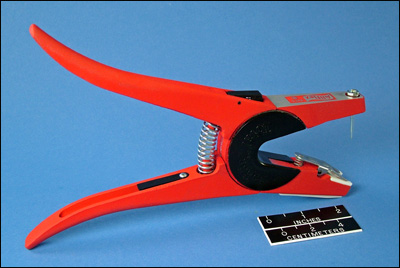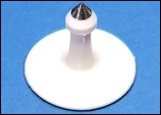GPS/Globalstar Solar Eartag
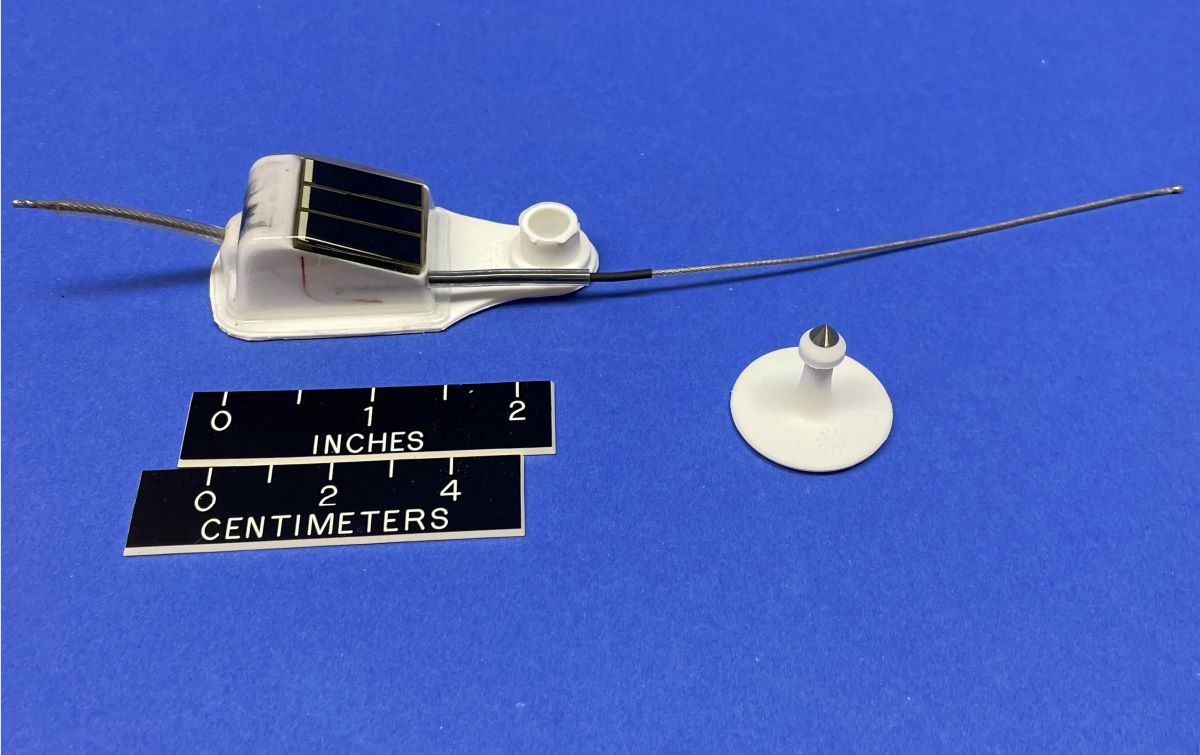
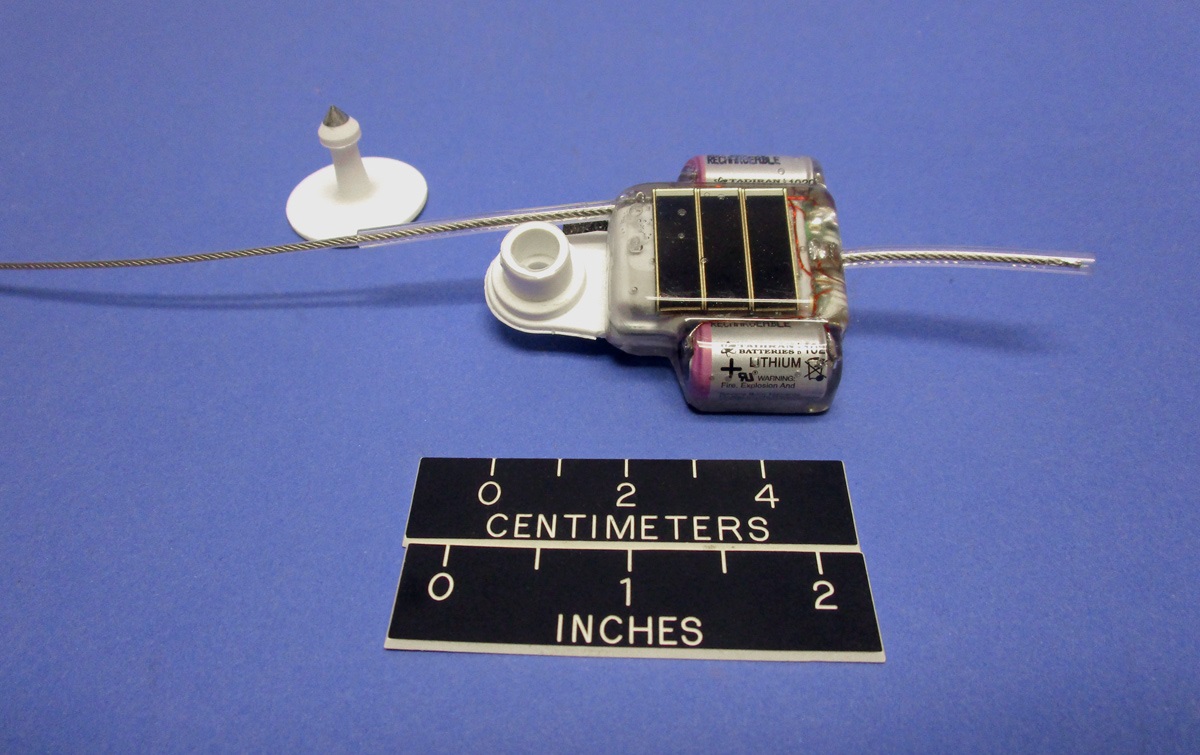
TGWES-4160-4 and TGWES-4260-4 model solar eartag
Eartag transmitters can be used as an attachment method on animals with changing neck girth (i.e. juveniles, buck deer, and similar ungulates) where a collar may not be suitable.
Models
| Model |
Dimensions
L x W x H (in, cm) |
Weight (g) |
| TGWES-4160-4 |
1.62 x 1.15 x 0.75
4.11 x 2.92 x 1.91 |
28 |
| TGWES-4260-4 |
2.30 x 1.76 x 0.57
5.84 x 4.48 x 1.44 |
36 |
Assuming 6 hours of sun per day at 10% of peak solar intensity:
3 GPS locations and Globalstar transmissions per day with 6 hours of VHF
OR 4 GPS locations and Globalstar transmissions per day without VHF
4 days reserve of full operation without sunlight using the above programming for TGWES-4260-4, 2 days reserve for TGWES-4160-4.
The number of GPS locations and Globalstar transmissions are temporarily reduced if the unit operates for an extended period of time with reduced sunlight.
Key Features
- Eartag units are often selected for monitoring juvenile animals. They are quickly and easily attached to animals in the field. They accommodate growth and are used as an alternative to complicated expansion-breakaway collars.
- Solar powered eartags provide a longer operational life than eartags powered by lithium primary batteries.
- A specialized attachment tool is required for applying the eartag and is available directly from Telonics.
- In addition to the GPS and Globalstar portions of these units, they typically include a VHF transmitter. The VHF transmitters can be used to locate or monitor the eartags from the ground or aircraft, including aiding in recovery of an eartag at the end of a study.
- Users can program or reprogram Telonics GPS/Globalstar units through use of Telonics Product Programmer (TPP). TPP uses a graphical user interface, and makes it possible for users to program their own systems prior to deployment.
- GPS/QFP collection schedules, Globalstar transmission schedules, VHF schedules, and sensor options can all be user-defined. Scheduling can be programmed to change over time (e.g. seasonal changes where monitoring might be less intensive at certain times of the year).
- Data retrieved through the Globalstar system, or downloaded from an eartag in hand, are processed using Telonics Data Converter (TDC). TDC is used to convert raw data from Telonics transmitters into data reports and to display locations on Google Earth and Google Maps. You can review TDC reports in Microsoft Excel or other spreadsheet programs.
- The most recently received location and status of each of your GPS-Globalstar transmitters can also be obtained on smart phones or other devices without TDC loaded, via Telonics-provided username and password access through the Telonics Status Webpage.
- All positions determined and sensor data collected is stored-on-board the eartag, thus if the eartag is able to be recovered, stored data can supplement what was transmitted through Globalstar.
- A Real-time clock calendar controls all timing functions and is re-synchronized with GPS time to assure high accuracy timing. All timing is programmed using Coordinated Universal Time (UTC).
- Optionally delivers data to EarthRanger, allowing you to map historical and real-time locations online and create a unified view of data from Telonics collars and other sources.
- Optionally delivers data to Movebank, allowing you to map, manage, analyze, and optionally share your data with collaborators or the public.
Features relative to the Globalstar system
- The Globalstar satellite network consists of 48 satellites in low-earth orbit. Overpasses provide continuous coverage over most terrestrial areas of the world, but the system is not worldwide because of its reliance on ground stations. Data received by the satellite is relayed to a ground station in real time and are available to the user within minutes. The coverage map for the Globalstar simplex system as used on wildlife is indicated by the map below. Areas in orange are primary coverage areas and those in grey crosshatch are areas of fringe coverage.
* Note: Due to the fluid situation between Russia and Ukraine, the Globalstar coverage may be affected in some areas.
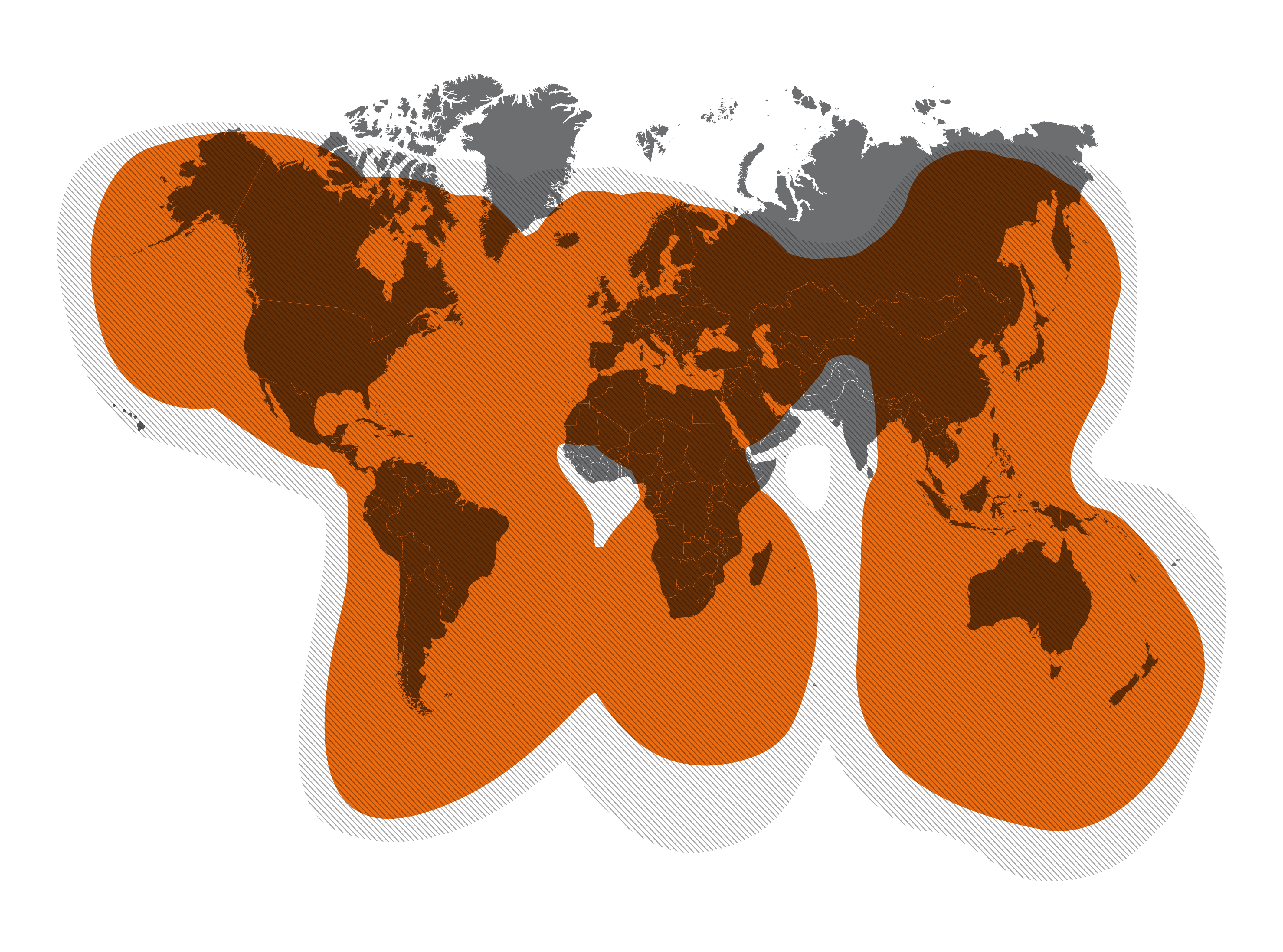 Previous Coverage Map
Previous Coverage Map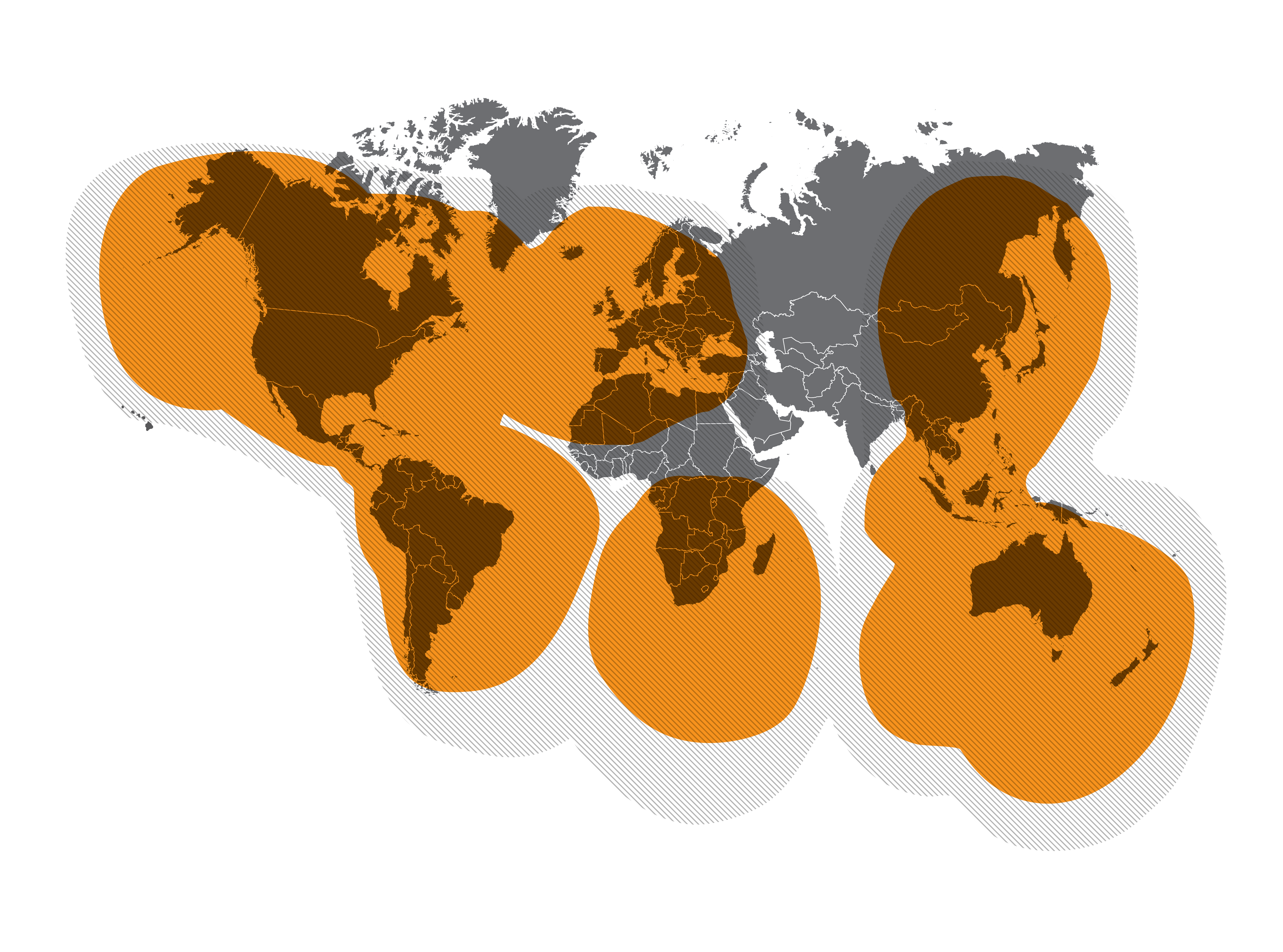
- The Globalstar simplex system provides a one-way link from the unit on the animal to the satellite, and then on to the researcher. The unit does not "know" when a transmission was successfully received, so as a default Telonics units transmit each data packet three times within about 20 minutes. This is considered a single Globalstar transmission, and it results in near 100% transmission success when the unit has a clear view of the sky. If units will be deployed in areas where the view of the sky may frequently be blocked by topography or dense vegetation, it is advisable to either provide additional data redundancy in transmissions and/or recognize that not all data will get through. When specific transmission times are defined, users should select a transmission time when they think the animal/transmitter is most likely to be in an area with good access to satellites (e.g. not when it would predictably be in a den or an area with dense cover).
- GPS-Globalstar models support two different message formats: a short message that holds only one GPS fix or a longer message that holds ~6 GPS fixes. The longer message format provides reduced monthly costs and slightly longer battery life; however, the shorter message can provide somewhat better transmission success from under vegetative cover and lets you receive the current location more frequently (for real-time tracking).
- Units may optionally be configured to collect QFP locations and store these locations on board the unit. QFP is Telonics quick fix positioning technology that obtains the data necessary to calculate a GPS position in as little as about 5 seconds. QFP locations can be obtained and stored with much less energy than traditional GPS positions; however, it not practical to transmit QFP locations via Globalstar. If recovery of the eartag can be expected, some applications can benefit from collection of numerous QFP positions, which are stored-on-board for download with the eartag in hand; and less frequent GPS positions which are transmitted through the Globalstar system.
- Transmissions can contain a mortality flag (which relates to whether there has been movement detected by an accelerometer within a user-defined period) and a low-voltage flag (which indicates the battery may die soon). You can receive real-time notification of mortality events via email at no additional charge.
- Activity or temperature data can be collected and stored on board, and be downloaded if the eartag is recovered, but it is not normally practical to transmit activity or temperature data using Globalstar.
- Telonics GPS Globalstar units are FCC and IC certified and available for use throughout the United States and Canada with no additional licensing required for the data transfer component.
- Data is normally retrieved through a third-party, AssetLink Global, which offers the least expensive data retrieval option for users. Globalstar data retrieval rates are lower than other satellite-based systems (~$5.00/unit/month with one daily transmission, $3.00 a month extra per additional daily transmission).
Eartag Attachment Tools
Replacement barbs
Electronic Specifications - GPS/Globalstar - Show
TGW-xxxx Terrestrial Wildlife Configurations
General System Specifications
| Timing Accuracy | Timing is synchronized to GPS time when available. If the GPS time is not then internal timing accuracy is:
6 min/year at 25° C
30 min/yr -20 to +40° C
47 min/yr -40 to +70° C |
|---|
| Available Sensors | Mortality, Activity, Temperature, Low Voltage |
|---|
| Memory Capacity | Capable of storing 100K fixes in nonvolatile flash memory in association with other sensor data. |
|---|
GPS Receiver Specifications
| Performance | -163 dBm tracking sensitivity -147 dBm acquisition sensitivity |
|---|
| Datum | WGS-84 |
|---|
| Time to First Fix (TTFF) | 35sec typical (with clear view of sky)
Quick Fix Pseudoranging (QFP) 3 sec typical (with clear view of sky) |
|---|
Globalstar Transmitter Module Specifications
| General | FCC ID L2V-STX3
Industry Canada ID 3989A-STX3
Frequency Range 1610-1620 MHz
Applicable FCC Rules CFR Title 47, parts 2, 15, and 25
Power Output 100mW |
|---|
| Mechanical/Environmental | Operating Temperature Range -40 to +70 °C |
|---|
| Globalstar Antenna Specifications | In collar-mounted wildlife configurations the Globalstar antenna is mounted on the dorsal surface of the neck. The antenna is installed in a high impact nonconductive plastic housing. The form of the housing presents sloping sides so that it will be impervious to chewing and gnawing as is possible. A highly armored antenna cable connects the antenna to the instrument package. |
|---|
VHF Transmitter Component Specifications
OPERATION INTERLOCK: All elements of the VHF transmitter component are forced off whenever the Globalstar transmitter module is on. This interlock device forcibly prevents simultaneous operation of the two transmitters, thus they are not considered to be co-located under FCC regulations.
| Available Frequency Options | Option 700 138-175 MHz
Up to 230MHz supported. Contact Telonics for details. |
|---|
| Frequency Stability | Better than ±3 ppm at room temperature;
±5 ppm total tolerance over full temperature range |
|---|
| Operating Temperature | -40° to + 70° C |
|---|
| Pulse Width | Programmable (10 to 250 msec) |
|---|
| Pulse Period | Programmable (560 to 5000 msec)
5 separate pulse period values selectable:
Period 1 (indicates last GPS fix successful)
Period 2 (indicates last GPS fix QFP, if equipped)
Period 3 (indicates last GPS fix unsuccessful)
Mortality period (if no motion for selected time)
Dead Battery period |
|---|
| Available Sensors | Mortality Sensor (parameters are user programmable) |
|---|
| Transmitter Timing | Programmable seasons and duty cycles. |
|---|
| Power Output | Programmable Low/Medium/High power. Effective Isotropic Radiated Power (EIRP) varies, depending on packaging, antenna configuration, and immediate environmental conditions.
* California Users: This transmitter meets the California requirement of EIRP <0.009 W for all configurations. |
|---|
| Emission Designator | 2k00P0N |
|---|
| Harmonic Suppression | Better than 30 dB (>40 dB typical) |
|---|
| Spurious Emissions | <-35 dBc at 10 kHz offset from carrier |
|---|
| Frequency | Aging: <2 ppm/yr
Shock: <1 ppm 3000 g x 0.3 ms x ½ sine x 3 dir |
|---|
| VSWR | RF output stable to 10:1 VSWR, all phases
Radiated harmonic levels are degraded with poor load VSWR.
Spurious emission specification maintained for >10:1 VSWR
|
|---|
| Programming | Transmitter parameters programmable via antenna "1-pin" interface and Telonics TPP PC software. |
|---|
Notice to United States Users
This device complies with Part 15 of the FCC Rules. Operation is subject to the following two conditions: (1) this device may not cause harmful interference, and (2) this device must accept any interference received, including interference that may cause undesirable operation.
The user is cautioned that changes or modifications not expressly approved by Telonics could void the user's authority to operate the equipment.
This device contains FCC ID: UQR-CMDCSTM3
To satisfy FCC RF Exposure requirements for mobile and base station transmission devices, a separation distance of 20cm or more should be maintained between the antenna of this device and persons during operation. To ensure compliance, operation at closer than this distance is not recommended.
Notice to Canadian Users
Under Industry Canada regulations, this radio transmitter may only operate using the antenna integrated into the device.
This device complies with Industry Canada license-exempt RSS standard(s). Operation is subject to the following two conditions: (1) this device may not cause interference, and (2) this device must accept any interference, including interference that may cause undesired operation of the device.
This device contains IC ID: 8863A-CMDCSTM3
Manual
Lithium Battery Shipping Regulations
Telonics Inc. ships all systems containing lithium batteries in accordance with the US Department of Transportation rules for hazardous materials set forth in 49CFR and the IATA Dangerous Goods Regulations.
Shipping dangerous goods can be complicated and confusing, consult a dangerous goods specialist if needed. The general requirements for shipping lithium batteries according to 49CFR are located in Part 173, Subpart 173.185 in the link below.
http://www.ecfr.gov/cgi-bin/text-idx?SID=e8334217c2c8d081457a5156872ad037&tpl=/ecfrbrowse/Title49/49cfrv2_02.tpl#0
Service Commitment
Since 1970, Telonics has built a reputation based on product quality, product support, service, and customer satisfaction. Telonics strives to produce the highest quality products, and to support those products accordingly.
Because of extreme conditions and the unpredictable nature associated with most telemetry applications, problems occasionally arise. Most problems can be resolved quickly. In all cases, we hope to be able to work in partnership with users to resolve problems to the user's satisfaction and to uphold our demonstrated commitment to excellence. If problems should arise, all products must be returned to our factory for failure analysis.
Warranty: GEN 4 GPS Systems - Show
Telonics warrants its GPS products to be free from defects in material and workmanship for a period of one year from the date acquired. Telonics does not warrant batteries.
Telonics designs and manufactures systems for a variety of applications using several satellite systems (GPS, Argos, Iridium, and Globalstar). At the time of manufacturing, Telonics equipment is tested to verify compatibility with the applicable satellite system(s). Telonics does not warranty equipment against changes in satellite system specifications or satellite operation after the date your equipment was manufactured. Unforeseeable or unplanned system changes would include, but are not limited to, elevated ambient noise levels in the radio frequency bands used for satellite communications, elimination of service in a region of the world, data outages due to technical problems within the satellite system network, or reductions in data transfer capability due to alterations in the constellation as a result of premature space vehicle failures or failure to replace space vehicles in a timely manner.
If a defect occurs, return the equipment to us within the proper time frame at the following address: TELONICS, 932 E. IMPALA AVENUE, MESA AZ USA 85204-6699. The customer shall arrange for and pay all shipping, insurance and related charges incurred in the shipment to and from Telonics under this warranty. Damage to any equipment resulting from misuse, accidents, unauthorized service, extreme conditions, or other causes, is excluded from this warranty. Telonics does not assume responsibility for loss or damage to equipment during shipment. Telonics does not assume responsibility for delays resulting from shipment on commercial or private carriers. We insure all equipment shipped from our facility and suggest that shipments to Telonics also be insured.
Upon the timely return to our facility, if defective, the product will be replaced or repaired at our discretion at no cost to the customer. This remedy is the exclusive remedy. This product is supplied without any further warranties or conditions, expressed or implied, including warranties of merchantability, quality or fitness for particular reason or those arising by laws, statutes or trade usage or course of dealing.
The entire risk, as to the results and performance of the product, is assumed by the customer. Neither Telonics, nor its suppliers, shall have any liability to the customer or any other person or entity for any indirect, incidental, special, or consequential damage whatsoever, regardless whether Telonics has been told of the possibility of such damages or that such damages might be foreseeable. Telonics has no responsibility or liability for the claims of any third party. The maximum aggregate to the customer, of Telonics and its suppliers, shall not exceed the amount paid by the customer for the product.





